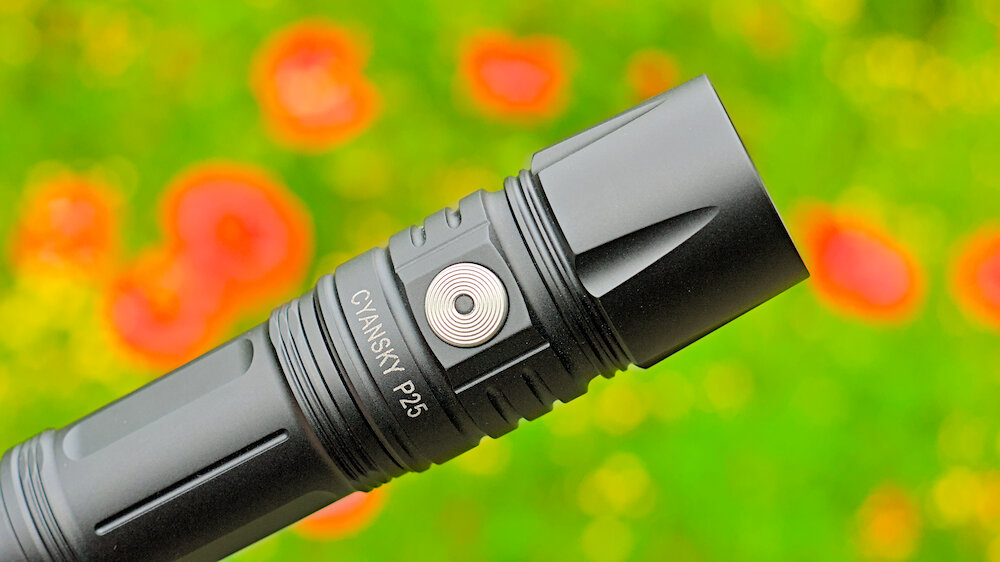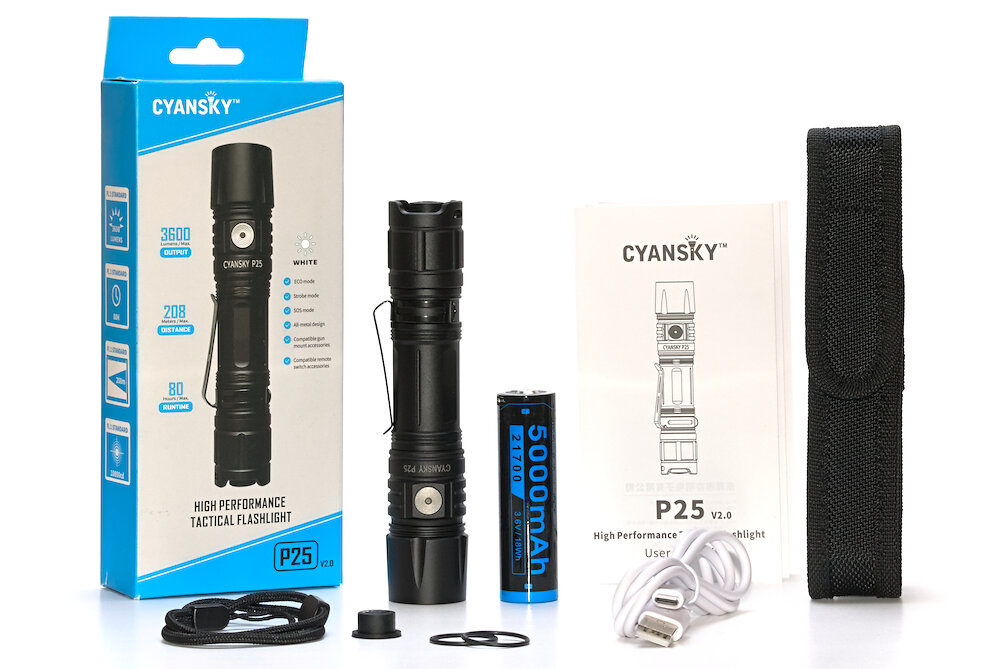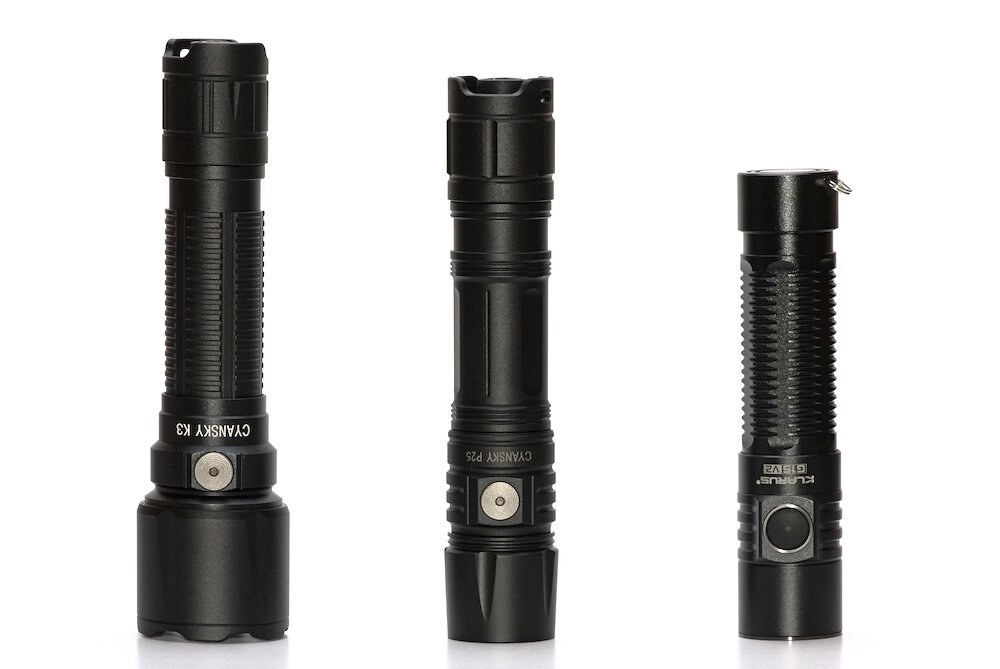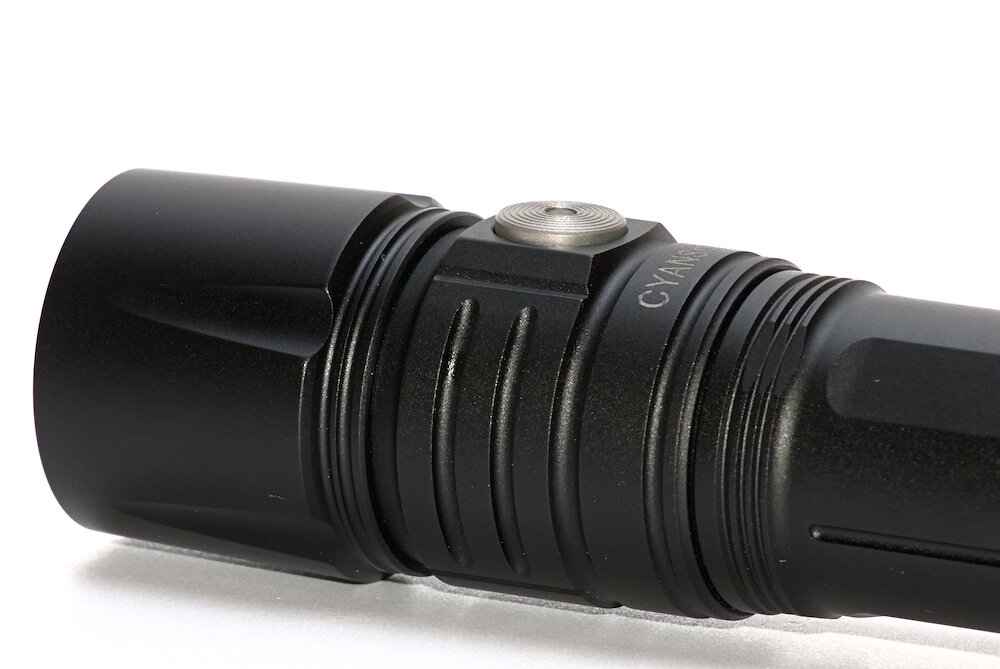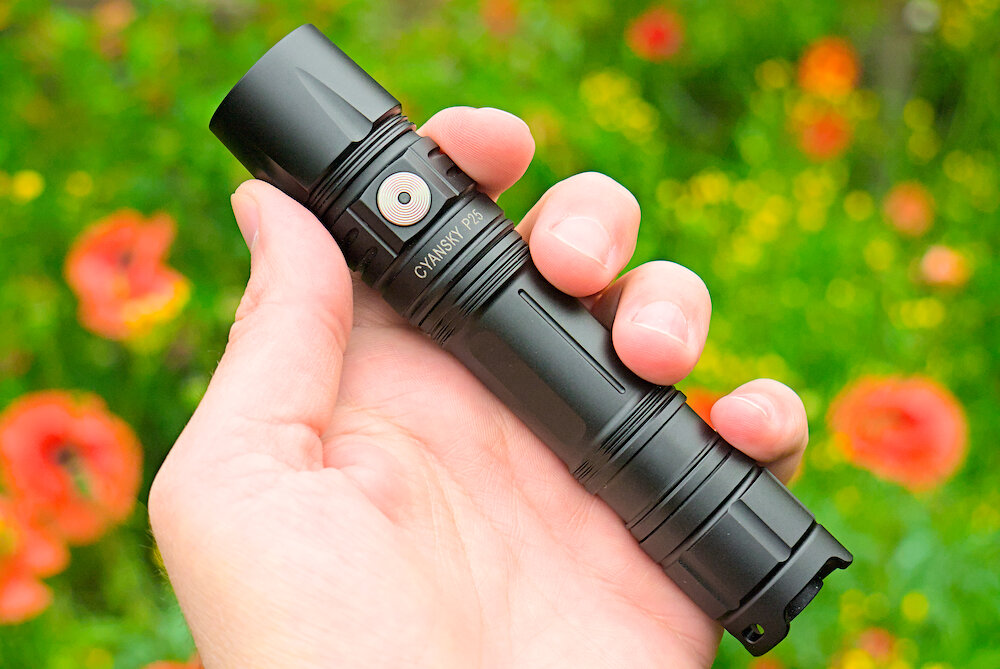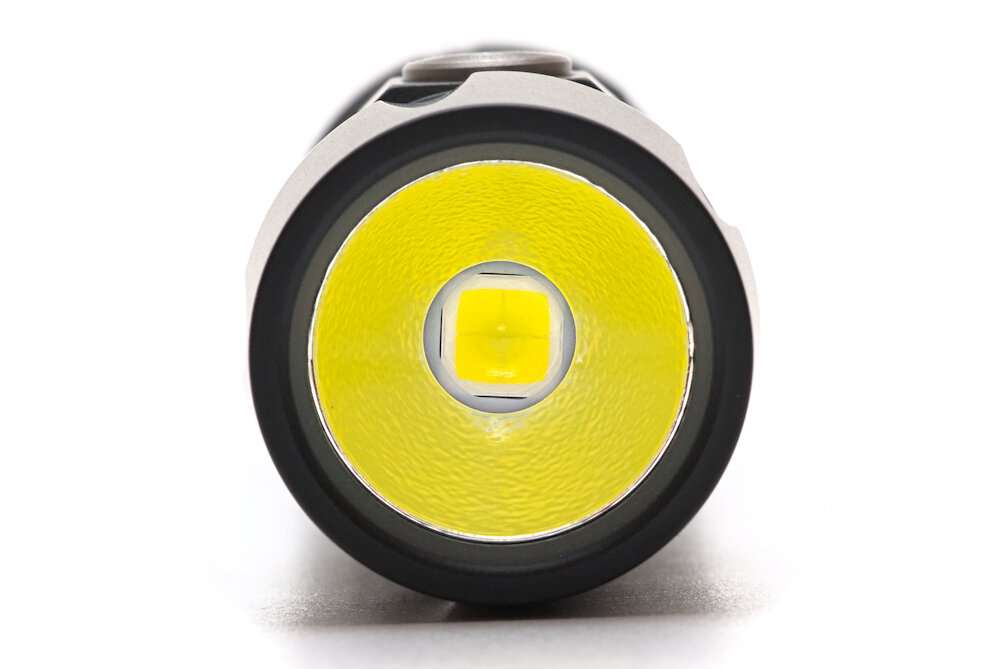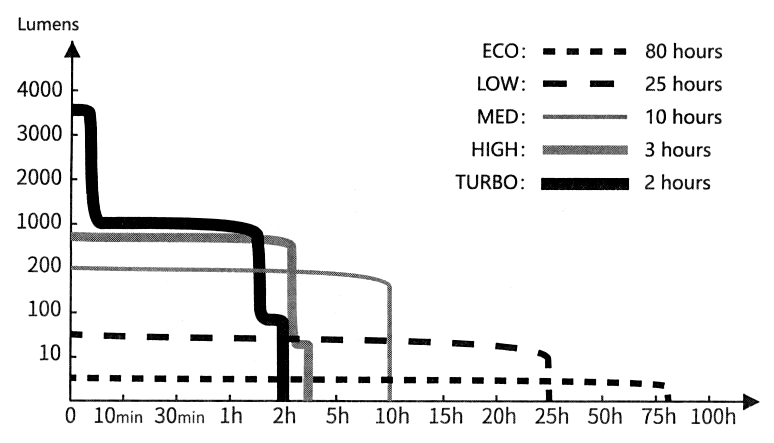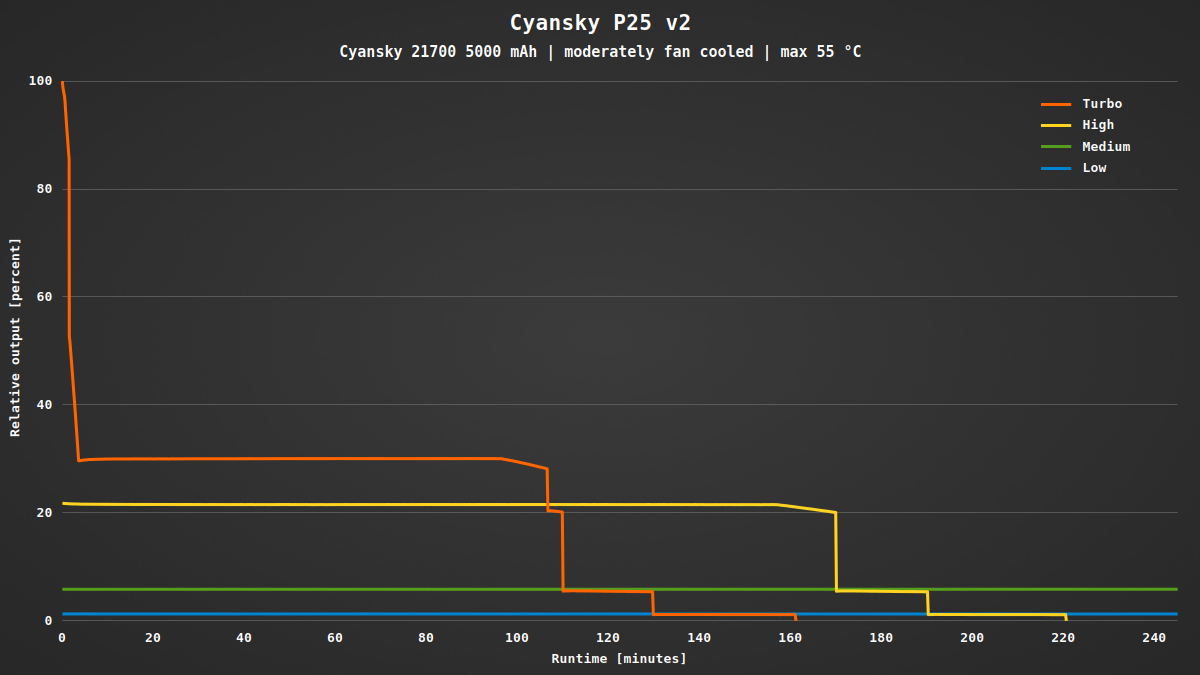For a while I use a Cyansky K3 v2 as my go-to pocket thrower. But as a thrower, it needs a nice flooder as a complement. Wouldn’t it be nice to have something with a similar appearance, UI and quality?
This flashlight was provided by Cyansky for this review, without any obligations. Thank you very much!
The review is also available in German on my website: SammysHP Blog › Cyansky P25 v2
Supplied parts and hardware
- 21700 Li-ion battery with 5000 mAh (3.78 V on delivery, button-top, protected, 76 mm long, integrated USB-C charging)
- Clip (already attached)
- Lanyard
- Holster
- USB-C cable
- Replacement O-ring (2x)
- Replacement tail switch cover (1x)
- Manual (EN, CN)
This is identical with the K3 v2.
In a direct comparison to the K3 v2 they are less similar. There are common elements like the switch, but also differences like the design of the battery tube.
The P25 v2 has a length of 145 mm and a maximum diameter of 30 mm. For a 21700 flashlight this is rather long, although the mechanical tail switch add some length. It weights 95 g plus 72 g for the battery.
Unlike the K3, the head is simple and comes without the crenelation on the bezel. The head tapers a little towards the front, which gives the lamp a slightly curved appearance.
The battery tube is one of the bigger differences to the K3. It comes without knurling or any other form of surface texture. Various small rings and grooves distributed over the body ensure that it does not slip out of your hand so easily. I would have preferred the battery tube of the K3.
A few cut-outs in the head set a small accent, but are not enough to prevent the lamp from rolling away on a flat surface (only the clip can really stop it from rolling away).
The tailcap has two holes to attach a lanyard. The two wings protrude over the switch, so that a tailstand is possible, albeit a bit unstable.
A holster is included for carry and storage. At first I had some difficulties putting the flashlight in as it is pretty tight. Over time the elastic should widen a bit to make it easier.
The attachment options of the holster are limited. A fixed loop with a width of 75 mm is all there is. No velcro loop, no D-ring.
Instead of a charging port in the flashlight – which is almost always susceptible to dirt and water – there is a USB-C port in the battery itself. This allows it to be charged outside of the flashlight, which is particularly useful when switching between multiple batteries.
During the charging process with up to 1.6 A (USB input), a small LED in the positive pole lights up red. When the battery is full, it changes to green.
The tailcap has good square threads. A double spring ensures low resistance for high performance. Should the tail switch cover ever become damaged, it can be easily replaced by unscrewing the ring in the tailcap. A replacement cover is included.
Although the spring is long enough to support an unprotected flat-top battery, only button-top batteries work due to a mechanical reverse polarity protection at the positive side.
Machining quality is perfect, no sharp edges at all. Water resistance is rated at IPX8 (2 m submersible) and drop height of 2 m as well.
User interface and features
The P25 has a tail switch (forward clicky) to turn the flashlight on and off as well as a metal side switch to change modes, which also includes the status LED.
The operation is almost identical to the K3 v2, only that an SOS mode has been added and the mode memory no longer works for turbo.
| State | Action | Function |
|---|---|---|
| Off | Press tail switch half | Momentary at last used level (Eco/Low/Medium/High |
| Off | Press tail switch completely | Turn on at last used level (Eco/Low/Medium/High) |
| Off | Hold side switch and press tail switch | Eco |
| On | Press tail switch completely | Turn off |
| On | Press side switch | Change brightness (Low → Medium → High → Turbo) |
| On | Hold side switch for 1 s | Strobe |
| Strobe/SOS | Press side switch | Back to last used brightness |
| Strobe/SOS | Hold side switch for 1 s | Switch between strobe/SOS |
If the flashlight was switched off in turbo, it starts in high afterwards. The missing memory for the turbo is a bit of a shame, since the difference between high and turbo is quite large and you need both buttons to switch on the flashlight into turbo.
An LED in the side switch shows the approximate charge level of the battery for three seconds after switching on:
| Color | State of charge |
|---|---|
| Green | 80% – 100% |
| Green blinking | 50% – 80% |
| Red | 20% – 50% |
| Red blinking | < 20% |
The flashlight is a bit too long to be able to reach both switches comfortably with one hand without having to change your grip. This can be a disadvantage, especially for a tactical flashlight. In addition, the side switch is not that easy to feel.
Illumination
Due to the large Cree XHP70.3 in the small, textured (“orange peel”) reflector, the P25 v2 creates a floody beam. Color rendition and tint are not among the strengths of the cold white LED. But it has a lot of power and creates up to 3600 lm in the P25. The glass has a “purple” anti-reflective coating.
Despite the floody beam, the large spot is still clearly visible. Cool white at its center, it is surrounded by a warmer corona, which softly blends into the cool white spill. Unfortunately, this is a typical light pattern from XHP LEDs with a dome.
In practice the flashlight nicely shows its strengths in close range operation. The entire environment is brightly illuminated and the small quirks of the beam are no longer noticeable. It reaches it limit at 50-100 m, when a thrower like the K3 v2 takes over.
As so often, d-c-fix “milky” is the perfect solution to smooth out any imperfections of the beam.
Driver and runtime
The runtime is only roughly specified by the manufacturer in the table. However there is also a runtime diagram in the manual.
| Mode | Brightness¹ | Runtime¹ | Intensity¹ (Throw²) | Current³ |
|---|---|---|---|---|
| Turbo | 3600 lm | 2 h | 10 800 cd (208 m) | 9.77 A |
| High | 800 lm | 3 h | 2 350 cd (97 m) | 1.38 A |
| Medium | 200 lm | 10 h | 600 cd (49 m) | 0.39 A |
| Low | 50 lm | 25 h | 144 cd (24 m) | 0.14 A |
| Off |
¹ According to manufacturer ² ANSI FL1 ³ Measured
The specifications fit quite well to my measurements. The turbo is maintained for over a minute, after which the driver reduces the brightness to around 30%, still above high level. Speaking of high level: The difference to the turbo is very large. That makes it even worse that after switching the flashlight on, you have to press another button to activate it.
The driver should have a temperature regulation to protect against overheating. In fact, the turbo is maintained a little longer when the lamp is cooled. If the lamp reaches 55°C, the brightness is reduced to the same value in both cases. The uncooled lamp then levels off at around 53°C, with cooling at only 37°C.
Since the XHP70.3 is only available in a 6/12 V configuration, the driver must be a boost regulator that increases the battery voltage accordingly. This also enables constant brightness and regulation without PWM.
If the battery voltage falls below 3.00 V, the status LED in the side switch starts flashing red. The lamp switches off at a voltage of 2.70 V.
Conclusion
The Cyansky P25 v2 is definitely a good complement to the K3 v2 with its floody beam, high brightness, similar appearance and almost identical UI.
Turbo uses the full potential of the flashlight. The brightness is maintained for more than a minute and by then the flashlight has heated up to 55°C. It’s just a pity that the turbo has to be reactivated via the side switch every time you turn the flashlight on.
If you got curious you can find the Cyansky HS6R here at AliExpress (no affiliate).
